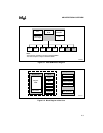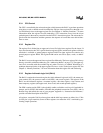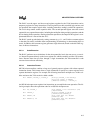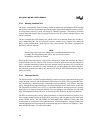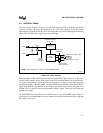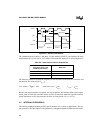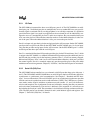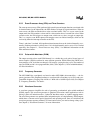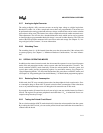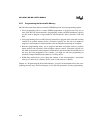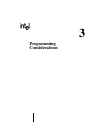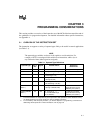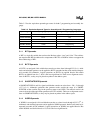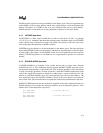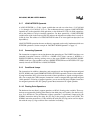
2-11
ARCHITECTURAL OVERVIEW
2.5.7 Analog-to-digital Converter
The analog-to-digital (A/D) converter converts an analog input voltage to a digital equivalent.
Resolution is either 8 or 10 bits; sample and convert times are programmable. Conversions can
be performed on the analog ground and reference voltage, and the results can be used to calculate
gain and zero-offset errors. The internal zero-offset compensation circuit enables automatic zero-
offset adjustment. The A/D also has a threshold-detection mode, which can be used to generate
an interrupt when a programmable threshold voltage is crossed in either direction. The A/D scan
mode of the PTS facilitates automated A/D conversions and result storage. See Chapter 12, “An-
alog-to-digital (A/D) Converter,” for more information.
2.5.8 Watchdog Timer
The watchdog timer is a 16-bit internal timer that resets the microcontroller if the software fails
to operate properly. See Chapter 13, “Minimum Hardware Considerations,” for more informa-
tion.
2.6 SPECIAL OPERATING MODES
In addition to the normal execution mode, the microcontroller operates in several special-purpose
modes. Idle and powerdown modes conserve power when the microcontroller is inactive. On-
circuit emulation (ONCE) mode electrically isolates the microcontroller from the system, and
several other modes provide programming options for nonvolatile memory. See Chapter 14,
“Special Operating Modes,” for more information about idle, powerdown, and ONCE modes, and
see Chapter 16, “Programming the Nonvolatile Memory,” for details about programming options.
2.6.1 Reducing Power Consumption
In idle mode, the CPU stops executing instructions, but the peripheral clocks remain active. Pow-
er consumption drops to about 40% of normal execution mode consumption. Either a hardware
reset or any enabled interrupt source will bring the microcontroller out of idle mode.
In powerdown mode, all internal clocks are frozen at logic state zero and the internal oscillator is
shut off. The register file and most peripherals retain their data if V
CC
is maintained. Power con-
sumption drops into the µW range.
2.6.2 Testing the Printed Circuit Board
The on-circuit emulation (ONCE) mode electrically isolates the microcontroller from the system.
By invoking the ONCE mode, you can test the printed circuit board while the microcontroller is
soldered onto the board.



